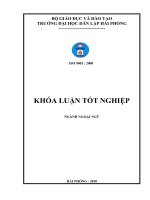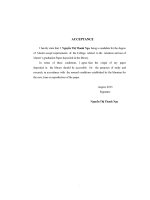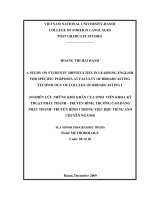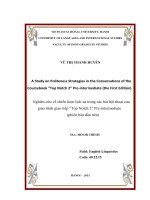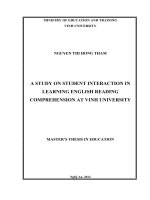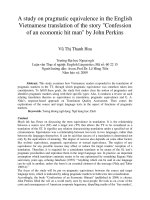A study on pragmatic equivalence in the English Vietnamese translation of the story Confession of an economic hit man by John Perkins
Bạn đang xem bản rút gọn của tài liệu. Xem và tải ngay bản đầy đủ của tài liệu tại đây (143.6 KB, 4 trang )
A study on pragmatic equivalence in the English
Vietnamese translation of the story "Confession
of an economic hit man" by John Perkins
Vũ Thị Thanh Hoa
Trường Đại học Ngoại ngữ
Luận văn Thạc sĩ ngành: English Linguistics; Mã số: 60 22 15
Người hướng dẫn: Assoc.Prof.Dr. Lê Hùng Tiến
Năm bảo vệ: 2009
Abstract. This study examines how Vietnamese readers responded to the translation of
pragmatic markers in the TT, through which pragmatic equivalence was somehow taken into
consideration. To fulfill these goals, the study first makes clear the notion of pragmatics and
identifies pragmatic markers along with their specific types. Also, it conducts a review on such
relating translation theories as equivalence in translation, pragmatic equivalence and E. A.
Nida‟s response-based approach on Translation Quality Assessment. Then comes the
explorations of the source and target language texts in the aspect of functions of pragmatic
markers.
Keywords. Tương đương ngữ dụng; Ngữ dụng học; Dịch
Content
Much ink has flown on discussing the term equivalence in translation. It is the relationship
between a source text (ST) and a target text (TT) that allows the TT to be considered as a
translation of the ST. It signifies any relation characterizing translation under a specified set of
circumstances. Equivalence was a relationship between two texts in two languages, rather than
between the languages themselves. It can be said that success of a translation is determined not
only by the equivalence of meaning. The degree of success also depends on some other factors
like stylistic equivalence, pragmatic equivalence or textual equivalence. The neglect of any
equivalence for any possible reasons may affect or reduce the target readers‟ reception of a
translation. Therefore, it is required for a considerate translator to be aware of the SL text‟s
pragmatic peculiarities and reproduce them in the target language one. In practice, an important
assumption which translators entertain seems to be one epitomized by something Eugene Nida
said many years ago, echoing Jakobson (1959): “Anything which can be said in one language
can be said in another, unless the form is an essential element of the message (Nida and Taber
1969:4).”
The focus of the study will be put on pragmatic equivalence between the source and target
language texts, which is indicated by taking pragmatic markers in both texts into consideration.
Accordingly, the book “Confessions of an Economic Hitman” (published in 2004) is chosen.
John Perkins lifted the veil on a world rarely seen by most people. He took us on a tour of the
costs and consequences of American corporate hegemony, dispelling myths of the „free market‟,
and forcing us to peer deep into our own souls. As Perkins states in his earlier works, "The world
is as you dream it," so the question is, “what will you dream?” This book is translated into
Vietnamese by a group of translators headed by Lê Đồng Tâm and has caught a great interest of
certain Vietnamese readers.
2. Purposes of the study
The study sets out to obtain the purposes as follows:
- To investigate the numerous functions of pragmatic markers in the ST as well as the treatment
of these markers in the TT.
- To study the dynamic equivalence between the original text and its translation.
- To suggest some implications for teaching and learning of English in general and translation
studies in particular.
3. Scope of the study
The study is focused on dynamic equivalence between “Confessions of an Economic Hit Man” &
its “Lời thú tội của một sát thủ kinh tế”. More specifically, the study is confined to the
relationship between pragmatic effect of pragmatic markers valid for different receiver groups
and habits of using these markers as well as of choosing language style in different language
pairs. The ground for the investigation in this study is the notion of dynamic equivalence
proposed by Nida & Taber (1969), Koller (1989), Baker (1992), Newmark (1981), Hatim and
Mason (1990) and Monia Bayar (2007) and the conception of pragmatics and pragmatic markers
suggested by Levinson (1983), Richards J.C, Platt J & Platt H (1992) and Fraser (1999)
4. Methodology
4.1. Research Questions
- What are pragmatic features of the source text and the receptors‟response to the translation
text?
- What are functions of pragmatic markers demonstrated in John Perkins‟s original work? Are
these markers treated equivalently in the translation text?
- To what extent are the original text and the translation pragmatically equivalent?
4.2. Methods
On the one hand, this study will be conducted under the corpus-based analysis. The aim of this
method is to attempt to outline the existing territory occupied by a new field of research in
translation studies. The research techniques are gathering quantitative data via a survey
questionnaire and presenting the results through statistics and tables. On the other hand, the
qualitative method will be resorted to as a supplementary one and not officially employed. It will
help understand the meaning of the numbers produced by quantitative methods. Using
quantitative methods, it is possible to give precise and testable expression to qualitative ideas.
This combination of quantitative and qualitative data gathering is often referred to as mixed-
methods research.
4.3. Data collection procedures
To investigate the pragmatic equivalence between the original text “Confessions of an Economic
Hit Man” and its Vietnamese translation, the following steps will be taken to collect data for the
study:
- doing document analyses to build up a strong theoretical framework for the study
- conducting a survey according to DCT method to identify and collect all pragmatic
markers explicit in the SL and TL texts.
In the DCT the discourse is structured so that part of it is left open and part closed. A
space is provided for subjects to supply speech act under investigation, but the response is
provided in order to cue the respondent as to the appropriate nature of the speech act realization,
i.e., the level of formality, and a description of the roles and relationship of the interlocutors.
Also the DCT is an effective means of studying the stereotypical perceived requirements
for a socially appropriate response and is a good way to gain insight into social and
psychological factors that are likely to affect speech and performance i.e. it avoids those very
context specific constraints that influence authentic data.
Cohen (1996, p.25) concludes that “discourse completion tests are effective means of
gathering a large amount of data quickly, creating an initial classification of semantic formulas,
and ascertaining the structure of speech act under consideration.”
- holding discussions with colleagues in the field to investigate their viewpoints and
experience in translating pragmatic markers
4.4. Data Analysis
To facilitate the process of analyzing data, the inductive method has been employed. Then,
comparison and contrast between the original and its translation are made as well as detailed
analyses are carried out so that a conclusion on the level of pragmatic equivalence between the
original and translation can be reached.
5. Design of the study
The study is composed of three main parts: the introduction, the development and the
conclusion.
The introduction states the rationale, purposes, scope, methodology and design of the study.
The development consists of three chapters:
Chapter one: Theoretical background.
Chapter two: Pragmatic markers in the original text.
Chapter three: Treatments of pragmatic markers in the Vietnamese translation.
The conclusion summarizes the main points discussed in the previous parts and puts forwards
some implications for translation learning and practice.
References
1. Apostel, Leo 1971. „Further remarks on the pragmatics of natural languages‟. In: Bar-
Hillel (ed.).
2. Baker M. (1992), In other Words A Coursebook on Translation, Routledge.
3. Bates E. (1976) Language and Context: The Acquisition of Pragmatics, Academic Press,
New York.
4. Bell R. (1991), Translation and Translating: Theory and Practice, Longman.
5. Brinton, L.J. (1996) Pragmatic markers in English: Grammaticalization and Discourse
Functions. Berlin: Mouton de Gruyter.
6. Catford, J.C. (1965), A linguistic Theory of Translation, Oxford university Express,
London.
7. Diep Quang Ban, (2004), Ngữ Pháp Tiếng Việt, Nhà Xuất Bản Giáo Dục.
8. Fawcett, P. (1997) Translation and Linguistics: Linguistics Theory Explained,
Manchester: St Jerome.
9. Fraser, B. (1999) “What are Discourse Markers?”, Journal of Pragmatics 31: 931-52
10. Gazdar, Gerald. 1979.Pragmatics: Implicature, presupposition, and logical form. New
York: Academic.
11. Haberlan, H.; Mey, J. “Editorial: linguistics and pragmatics”. Journal of Pragmatics, 1,
1977
12. Hatim B. & Mason I. (1990), Discourse and the translator, Longman
13. Hartman, R. R.K (1972) Contrastive Textology, Heidelberg: Julius Groos Verlag.
14. Holmes, J.S. (1988/2000) „The name and nature of Translation Studies‟, in Translated
Papers on literary Translation and Translation Studies, 2
nd
edn, L. Venuti
15. Hong, N.T.T (2006). MA Thesis: A Study on textual Equivalence Between some
Australian Short Stories and Their Vietnamese Translations. VNU, College of Foreign
Languages.
16. House (1977), A Model for Translation Quality Assessment, Tybingen: Gunter Narr.
17. Jakobson, R. (1966), “On linguistic Aspects of Translation” in R.A.Brower (ed), On
Translation, Oxford University Express, New York.
18. Jeremy Munday. (2001). Introducing Translation Studies, Theories and applications.
London and New York: Routledge, p. 36.
19. Jucker, A.H. (1993) „The Discourse Marker Well : A Relevance- Theoretical Account‟,
Journal of Pragmatics 19: 435-52.
20. Kelly, D. (1998), “Equivalence” in Baker, m and Malmkjer, k. (ed), Routledge
Encyclopedia of Translation Studies, Routledge, London.
21. Koller, W (1989), “Equivalence in Translation theory” in Chesterman, A. (ed), Readings
in Translation Theory, Oy Finn Lectura Ab, Funland.
22. Leech, Geoffrey. 1983.Principles of pragmatics. London: Longman.
23. Levinson, Stephen C. 1983.Pragmatics. Cambridge, England: Cambridge University.
24. Martin, R. L. 1971. „Some thoughts on the formal approach to the philosophy of
language‟. In: Bar-Hillel (ed.).
25. Peter Newmark, (1981). Approaches to Translation. Oxford and New York: Pergamon, p.
39.
26. Peter Newmark. (1988). A Textbook of Translation. London and New York: Prentice Hall
International (UK) Ltd, p. 49.
27. Polanyi, l. (1988) “A formal Model of the Structure of Discourse”, Journal of Pragmatics
12: 601-38.
28. Monia Bayar, (2007). To Mean or Not to Mean, Kadmous cultural foundation. Khatawat
for publishing and distribution. Damascus, Syria, p. 163.
29. Morris, C. (1938) 'Foundations of the Theory of Signs', in Carnap, R. Et al (eds.)
International Encyclopedia of Unified Science, 2:1, Chicago: The University of Chicago
Press.
30. Nida E.A (1964), Toward a Science of translating, Brill, Leiden.
31. Nida E.A and Taber, C.R. (1969), The Theory and Practice of Translation, Brill, Leiden.
32. Nida, E. A. & Taber, C. R. (1982). The theory and practice of translation (3rd ed.).
Leiden: E. J. Brill.
33. Polanyi, L. (1988) “A Formal Model of the Structure of Discourse”, Journal of
Pragmatics 12:601-38.
34. Redeker, G. (1990) “Ideational and Pragmatic Markers of Discourse Structure” Journal
of Pragmatics 14:367-81.
35. Richards J.C, Platt J & Platt H, Dictionary of Language Teaching & Applied Liguistics,
Longman.
36. Schiffrin, D. (1987), Discourse Markers. Cambridge University press.

